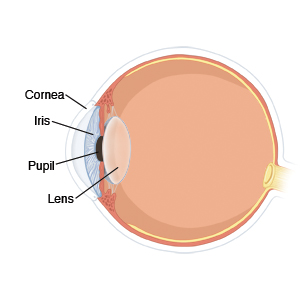You have an infection of the cornea (the clear part in the front of the eye) with the herpes simplex virus. This infection is called herpes keratitis. Herpes simplex is the same virus that causes cold sores and genital herpes.
Symptoms include a red, painful eye with sensitivity to light and blurred vision.
Herpes keratitis is a very serious disease. It often responds well to treatment. But if it isn't treated, it can cause blindness.
Treatment is often either with antiviral eye drops, pills, or both. If the infection is severe, an IV (intravenous) antiviral medicine might be used. You may be given corticosteroid eye drops as well. In rare cases, surgery is needed. These treatments will clear up the symptoms. But, like cold sores on the lip, the herpes infection in the eye can come back. Watch for the earliest signs of symptoms returning so you can start treatment right away. Prompt treatment reduces your chance of permanent eye damage. Follow your eye care provider's advice for reducing future outbreaks, such as avoiding sun exposure or tanning beds.
Home care
-
Use eye drops as directed.
-
You may use over-the-counter pain medicine unless another medicine was prescribed. Talk to your health care provider about using over-the-counter pain medicines safely. This is especially important if you have chronic liver or kidney disease, or ever had a stomach ulcer or gastrointestinal bleeding.
-
A cold pack may be put over the closed eye for 20 minutes at a time to ease pain. To make a cold pack, put ice in a plastic bag that seals at the top. Wrap the bag in a thin towel or cloth before using it.
Follow-up care
Follow up with the eye care provider you were referred to, or as advised. You should have another exam within 48 hours to be sure you are responding to the medicine.
When to get medical advice
Contact your health care provider right away if:
-
You have increasing eye pain or pain that doesn't improve after 24 hours.
-
Your vision gets worse.
-
You have thick discharge from the eye.
-
You have increasing redness of the eye.
-
You have swelling of the eyelids or painful blisters on the eyelids.
-
You have pain or redness in the other eye.


